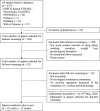Emotional labor as emotion regulation investigated with ecological momentary assessment - a scoping review
- PMID: 38347624
- PMCID: PMC10863272
- DOI: 10.1186/s40359-023-01469-9
Emotional labor as emotion regulation investigated with ecological momentary assessment - a scoping review
Abstract
Background: This scoping review's aim is to provide a comprehensive overview of ecological momentary assessment (EMA)- based research on emotional labor (EL) as emotion regulation (ER). This includes an examination of the theoretical foundation this research builds on, how the hypothesized relationships are investigated using EMA methods as well as the studies' findings themselves. We built on the work of Grandey and Melloy (J Occup Health Psychol 22:407-22, 2004), who broadly distinguished between the two regulatory strategies of deep acting (DA) and surface acting (SA), embedded in a hierarchical model of emotional labor, as a guiding theory for structuring this review.
Methods: To be included, studies had to use EMA to measure SA or DA, with no restrictions regarding population and date of publication. The electronic databases CINAHL, PsycArticles, PsycINFO, PSYNDEX, Embase, PubMed, and Web of Science were searched. Studies were included if they met the above criteria and were written in English or German. Out of 237 publications, 12 were chosen for this review.
Results: All studies were based on emotional labor theories, with Arlie Hochschild's theory being the most popular, followed by Alicia Grandey's emotional labor theory and its modifications (Grandey AA. Emotion Regulation in the Workplace: A New Way to Conceptualize Emotional Labor; Grandey AA. When "the show must go on": Surface acting and deep acting as determinants of emotional exhaustion and peer-rated service delivery. 2003). The methodological quality of the studies varied greatly. The results of the studies indicate that SA is influenced by negative events, trait SA, service innovation and certain emotions, while DA is influenced by positive events and emotional intelligence. Emotional labor benefits the organization, e.g., by improving customer conflict handling, but also causes harm by increasing employee withdrawal behavior. For the employee, emotional labor results in more harm than benefits.
Conclusions: The research area is still in its early stages and the findings are mostly consistent, but the small number of studies needs to be replicated to increase the reliability of the results. The lack of evidence for ertain hypotheses highlights the presence of unresolved relationships that require further exploration. We are only at the beginning of investigating emotional labor using ecological momentary assessment, and conducting more high-quality studies will significantly enhance our comprehension of emotional labor.
Keywords: Ambulatory Assessment; Ecological Momentary Assessment; Emotion Regulation; Emotional Labor; Experience Sampling; Job; Strain; Stress; Work.
© 2024. The Author(s).
Conflict of interest statement
The authors declare no competing interests.
Figures





Similar articles
-
Developing a structural equation model from Grandey's emotional regulation model to measure nurses' emotional labor, job satisfaction, and job performance.Appl Nurs Res. 2022 Apr;64:151557. doi: 10.1016/j.apnr.2021.151557. Epub 2022 Jan 2. Appl Nurs Res. 2022. PMID: 35307133
-
Reliability and Validity of Ecological Momentary Assessment Response Time-Based Measures of Emotional Clarity: Secondary Data Analysis.JMIR Ment Health. 2024 Jul 18;11:e58352. doi: 10.2196/58352. JMIR Ment Health. 2024. PMID: 39024004 Free PMC article.
-
Exploring emotions beyond the laboratory: A review of emotional and physiological ecological momentary assessment methods in children and youth.Psychophysiology. 2024 Dec;61(12):e14699. doi: 10.1111/psyp.14699. Epub 2024 Oct 4. Psychophysiology. 2024. PMID: 39367539 Free PMC article. Review.
-
Testing a multidimensional model of emotional labor, emotional abilities, and exhaustion: A multilevel, multimethod approach.J Occup Health Psychol. 2020 Feb;25(1):46-67. doi: 10.1037/ocp0000166. Epub 2019 Aug 29. J Occup Health Psychol. 2020. PMID: 31464459
-
What Can We Learn From More Than 140,000 Moments of Ecological Momentary Assessment-Assessed Negative Emotion and Ambulatory Blood Pressure? A Systematic Review and Meta-Analysis.Psychosom Med. 2021 Sep 1;83(7):746-755. doi: 10.1097/PSY.0000000000000966. Psychosom Med. 2021. PMID: 34267091
Cited by
-
A longitudinal analysis of physical exercise in shaping language learners' emotional well-being: a comparative analysis between L1 and L2 students.BMC Psychol. 2025 Jan 16;13(1):44. doi: 10.1186/s40359-024-02338-9. BMC Psychol. 2025. PMID: 39819799 Free PMC article.
-
The mediating role of perceived overqualification in the relationship between emotional labor and mindfulness among nurses in China.Front Public Health. 2025 Mar 17;13:1519192. doi: 10.3389/fpubh.2025.1519192. eCollection 2025. Front Public Health. 2025. PMID: 40165982 Free PMC article.
References
-
- Levi L. Guidance on work-related stress: spice of life or kiss of death? Luxembourg, Lanham, Md.: Office for Official Publications of the European Communities ; Bernan Associates [distributor]; 2000.
-
- Gross JJ. Handbook of Emotion Regulation. New York: Guilford Press; 2014.
-
- Weiss HM, Cropanzano R. Affective events theory: a theoretical discussion of the structure, causes and consequences of affective experiences at work. In: Research in organizational behavior: An annual series of analytical essays and critical reviews. US: Elsevier Science/JAI Press; 1996. p. 1–74.
-
- Leiter MP, Maslach C. Areas of worklife: a structured approach to organizational predictors of job burnout. In: Research in Occupational Stress and Well-being. Bingley: Emerald (MCB UP ); 2003. p. 91–134.
Publication types
MeSH terms
LinkOut - more resources
Full Text Sources
Research Materials
Miscellaneous

